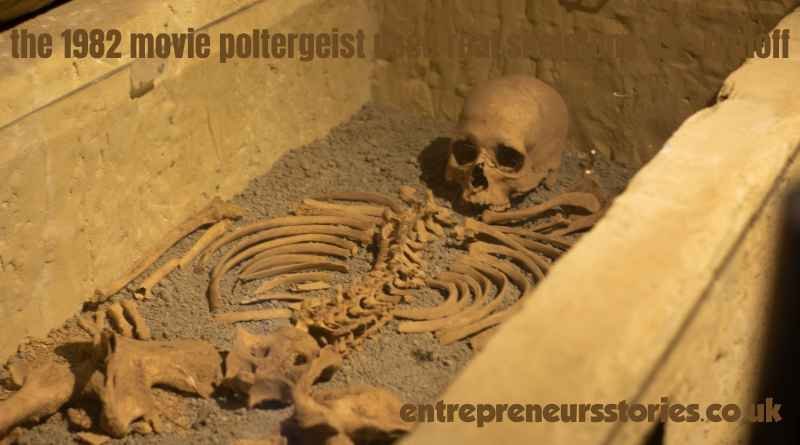The 1982 horror film “Poltergeist” is a cult classic, revered for its chilling storyline and terrifying special effects. However, one of the most macabre and intriguing facts about the movie is the use of real human skeletons in several scenes. This controversial decision has fueled countless urban legends and speculations over the years, adding to the film’s eerie legacy. In this article, we delve into the story behind this unsettling choice, exploring the reasons, reactions, and repercussions of using real skeletons on set.
The Decision to Use Real Skeletons

The choice to use real human skeletons in “Poltergeist” was primarily driven by practical and economic reasons. At the time, the cost of creating realistic plastic skeletons was significantly higher than obtaining real human skeletons from medical supply companies. In an interview, special effects artist Craig Reardon revealed that real skeletons were cheaper and readily available, making them a practical option for the film’s budget constraints.
Moreover, the film’s creators believed that real skeletons would enhance the authenticity and horror of the scenes. They wanted the film to stand out in the crowded horror genre, and using genuine human remains was seen as a way to achieve a more visceral and convincing effect. This decision, however, was not without its ethical and psychological ramifications.
The Infamous Swimming Pool Scene
One of the most iconic and terrifying scenes in “Poltergeist” involves actress JoBeth Williams, who played the character Diane Freeling, being pulled into a muddy swimming pool filled with skeletons. Unbeknownst to Williams at the time, the skeletons surrounding her were real. The scene’s intense realism and the subsequent revelation that the skeletons were genuine contributed to the film’s haunting legacy.
Williams later recounted her experiences filming the scene, expressing her shock and discomfort upon learning that she had been in close contact with actual human remains. This revelation not only unsettled the cast and crew but also sparked widespread discussion among audiences and the media about the ethical implications of using real skeletons in film production.
Audience Reactions and Urban Legends
The use of real skeletons in “Poltergeist” quickly became a hot topic among horror enthusiasts and the general public. Many viewers were both horrified and fascinated by the idea, which led to a proliferation of urban legends and rumors. Some speculated that the use of real skeletons had cursed the film, pointing to the tragic deaths of several cast members as evidence of a supernatural backlash.
The so-called “Poltergeist curse” became an integral part of the film’s mythology, with numerous theories circulating about the potential consequences of disturbing the dead. While there is no concrete evidence to support these claims, the eerie coincidences and untimely deaths associated with the film have only added to its mystique and enduring popularity.
Ethical and Psychological Implications
The ethical implications of using real human skeletons in “Poltergeist” have been a subject of intense debate. Critics argue that it is disrespectful to the deceased and their families to use human remains for entertainment purposes. They contend that the practice commodifies and dehumanizes the dead, reducing them to mere props in a horror movie.
On the other hand, some defend the decision, noting that the skeletons were obtained legally from medical supply companies, where they were already being used for educational and scientific purposes. They argue that repurposing these skeletons for film is not inherently unethical, provided that the remains are treated with respect and dignity.
Psychologically, the use of real skeletons can have a profound impact on both the actors involved and the audience. For the actors, the knowledge that they are interacting with genuine human remains can evoke strong emotional reactions, ranging from discomfort and fear to fascination and curiosity. For the audience, the realism added by real skeletons can heighten the film’s horror, making the experience more immersive and unsettling.
The Legacy of Poltergeist and Real Skeletons in Film
The legacy of “Poltergeist” is inextricably linked to the decision to use real skeletons, and this choice has influenced the horror genre in significant ways. The controversy surrounding the film highlighted the lengths to which filmmakers might go to achieve authenticity and realism, sparking a broader conversation about the ethical boundaries of special effects in cinema.
Since “Poltergeist,” the use of real human remains in film has become a rarity, largely due to advancements in special effects technology and increased awareness of ethical considerations. Modern filmmakers can now create incredibly realistic skeletons and other props without resorting to the use of actual human remains, thus avoiding the ethical and psychological issues associated with the practice.
However, the story of “Poltergeist” and its real skeletons continues to captivate audiences, serving as a reminder of the film’s unique place in horror history. The movie’s blend of supernatural terror and real-life controversy has ensured its status as a timeless classic, with the tale of its skeletons enduring as a fascinating and chilling footnote.
Conclusion: A Haunting Legacy
The 1982 movie “Poltergeist” stands out not only for its terrifying narrative and groundbreaking special effects but also for the controversial use of real human skeletons. This decision, driven by practical and economic considerations, has left an indelible mark on the film and its legacy. The reactions of the cast and crew, the audience’s fascination, and the ensuing urban legends have all contributed to the film’s enduring mystique.
While the ethical implications of using real skeletons in film remain a topic of debate, there is no denying that the story adds a layer of intrigue and horror to “Poltergeist.” The movie’s legacy is a testament to the power of film to provoke thought and emotion, blurring the lines between fiction and reality. As technology advances and ethical standards evolve, the story of “Poltergeist” serves as a historical reference point, reminding us of the complexities and responsibilities inherent in the art of filmmaking.
Also Read Related Posts: Griffin Cleverly: Age, Career, Family, Net Worth, Height & Bio 2024

